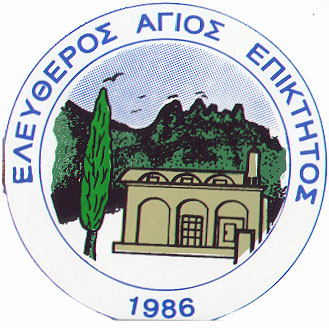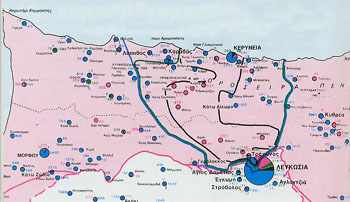|
||||||||||||||
|
|
 The emblem of "Free Ayios Epiktitos" Refugees Federation Found: 1986 |
||||||||||||
![]()
Biography of Saint Epiktitos
Turkish Invasion in Cyprus- July 20th 1974
Ayios Epiktitos has been occupied by Turkish troops since July 27 1974. It is one of the first villages that have been captured and are still under Turkish Military occupation in the Kyrenia district after the Turkish troops invaded the island July 20 1974. Ayios Epiktitos was captured during a period of cease-fire. (UN Security Council Resolution No. 353 Jul/20/1974)
Click map to enlarge.

Click here for map details
and explanatory notes.
Back to Top
Biography of Ayios Epiktitos (Saint Epiktitos)
Ayios Epiktitos village took its name from Ayios Epiktitos (Saint
Epiktitos). According to the historian Leontios Macheras he
was one of the 300 Christians that came from Palestine to Cyprus at 1187 A.C. He
lived and died in the location where our village lies. The village was
established after 1200 A.C. (according to "Horia ke polis" (Villages
and towns) of historian Kliridis).
Greek labor worker living in Germany, Ayios Epiktitos along with the rest 300
Greek Christian soldiers were traveling from Germany to Jerusalem during the
Second Crusade 1147-1149 in order to free the Holy lands from the barbaric hands
of the Muslims. Because of several problems the crusade ended before even
reaching Palestine. The 300 Greek soldiers decided to move on to Jerusalem to
worship since Jerusalem was still under European rule. After reaching Jerusalem
and worshiped at the Holy grave, they decided to split and dedicate to ascetic
life at the Jordan desert plains. Despite their strong will to dedicate their
life to God following the strict rules of the ascetic life, they were attacked
and persecuted by Arabs and Latins. Under the circumstances they decided to flee
towards Cyprus for safer shelter. During their journey, the boat sunk just
outside the shores of Paphos, at the south part of the island but nobody was
hurt. They split again throughout Cyprus to dedicate their lives to God through
the ascetic life. Some of them went on the mountainous terrains, others found
caves or even dig holes on the ground to be their shelter.
Leontios Macheras, the chronographer of Cyprus, in his "Chronicle" describes the particular event.
<<'Οταν οί Σαρακηνοί επήραν τήν γήν τής Επαγγελίας, τότε εβγήκαν οί πτωχοί Χριστιανοί απού εγλυτώσαν καί επήγαν όπου ηύραν καταφύγιν ήσαν αρχιεπισκόποι, επισκόποι, ιερείς, λαϊκοί καί επήγαν όπου φτάσαν καί ήρταν καί είς τήν περίφημον Κύπρον μία συντροφιά, όπου ήσαν τ' (300) ονομάτοι, καί γροικώντα ότι Έλληνες εφεντεύγαν τόν τόπον, διά τόν φόβον επήγαν είς τό ένα μέρος καί είς τό άλλον καί έσκαψαν τήν γήν καί εμπήκαν μέσα καί επροσεύχονταν τώ Θεώ καί ήσαν δύο τρείς αντάμα, καί είχαν τινάν δουλευτήν απού τούς εδούλευγεν τό εχρειάζουνταν διά τήν ζωήν τούς καί εποθάναν είς τόν αυτόν νησίν, καί πολλοί εξ' αυτών τούς εφανερώθησαν δι' αγγέλου άλλοι διά τά θαυμαστά θαύματα. >>
Historian Macheras gives 67 names out of the 300 among them the name
of Ayios Epiktitos.
Ayios Epiktitos is said to have traveled to the North mountainous terrain of
Cyprus, "Pentadactylos" and settled at the location of "Kaza
Pifani" (Καζά Πιφανή)
the nowadays known village of Kazaphani which is approximately 4 miles away from
the town of Kyrenia.
<<Είς τήν
Περιστερώναν
τής Μεσαορίας
ευρίσκεται ο
Άγιος
Αναστάσιος ό
θαυματουργός
είς την
Ορμετίαν (Ορμήδια)
ό Άγιος
Κωνσταντίνος
στρατιώτης ...
καί προς τού
Κάζα Πιφάνη ό
Άγιος
Επίκτητος. >>
 |
Το
Απολυτίκιον
του Αγίου
Επικτήτου |
| «Της ερήμου πολίτης και εν σώματι άγγελος και θαυματουργός ανεδείχθης Θεοφόρε, πατήρ ημών Επίκτητε. Νηστεία αγρυπνία, προσευχή, ουράνια χαρίσματα λαβών, θεραπεύεις τους νοσούντας και τας ψυχάς των πίστη προστρεχόντων Σοι. Δόξα τω δεδώκοτι Σοι ισχύ. Δόξα τω σε στεφανώσαντι. Δόξα τω ενεργούντι δια σου πάσιν ιάματα.» |
At the beginning the Saint lived at a totally isolated location. Later on he found a cave and there he set up his ascetic shelter. His struggle was multilateral, intensive, and continuous. His weapons, the prayer, fast, study and exercise. His yearning is to defeat his weaknesses and his passions; to defeat his inferior self and become the one that follows the will of God. With this way of life the result was direct. His spirit and his heart are enlightened and the dedicate Saint achieves what he struggles. He achieves to become one of God's favorites, honest, Saint.
Back to Top
Church
After the Saint's death, his holy body was buried inside his cave. They also baptized the new village under his name to honor him. His holy cave was the first church of the village and still exists. It is like a catacomb, or burial chamber, that was built by digging the rock. You can reach the cave by stepping down a cylindrical stair. At the end of the stair, there was a spring with water used by the Saint for surviving, and also watering the few plants for a small harvest. Inside the cave you can see the rocky bed and a rock that looks like a head that was used as a pillow by the Saint. In a corner lies the grave of the Saint. The church of Ayios Epiktitos (Saint Epiktitos) was built at the end of the 12th century. In 1856, according to "Historical Cyprus" of Rupert Gunnis, the icon of Ayios Epiktitos was transferred from the cave into the church upstairs.
The destroyed church of Ayios Epiktitos in our village, now converted into a Muslim mosque. |
|
|
|
This is a picture of the church of Ayios Epiktitos in our village. The cross is cut by Turkish barbarians, the windows opened and the whole condition of the church and the yard is very bad. Recently, the church has been transformed to a Muslim Mosque. This is to remind to all civilized world that Turkish barbarians constantly and systematically destroy Greek cultural monuments without any respect for the holy symbols of Christianity. |

